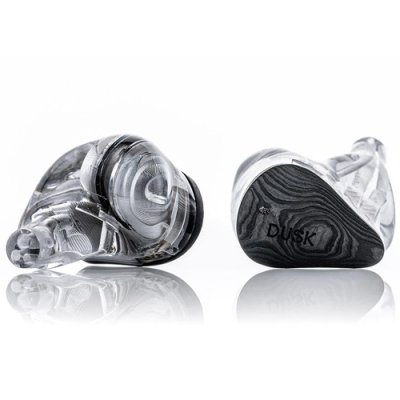Moondrop x Crinacle Dusk and FlipEars Aegis use 2DD+2BA+2PLA and 1DD+1BC driver setups respectively. Moondrop x Crinacle Dusk costs $400 while FlipEars Aegis costs $479. FlipEars Aegis is $79 more expensive. Moondrop x Crinacle Dusk holds a clear 0.6-point edge in reviewer scores (7.7 vs 7.2). User ratings place Moondrop x Crinacle Dusk at 7.7 and FlipEars Aegis at 8. FlipEars Aegis has better bass with a 0.7-point edge, Moondrop x Crinacle Dusk has significantly better mids with a 1.9-point edge, Moondrop x Crinacle Dusk has significantly better treble with a 1.5-point edge, Moondrop x Crinacle Dusk has slightly better dynamics with a 0.3-point edge, Moondrop x Crinacle Dusk has significantly better soundstage with a 2.5-point edge and Moondrop x Crinacle Dusk has better details with a 0.5-point edge.
Insights
| Metric | Moondrop x Crinacle Dusk | FlipEars Aegis |
|---|---|---|
| Bass | 7.3 | 8 |
| Mids | 7.4 | 5.5 |
| Treble | 7.8 | 6.3 |
| Details | 8 | 7.5 |
| Soundstage | 7.5 | 5 |
| Imaging | 7.5 | 7.5 |
| Dynamics | 7 | 6.8 |
| Tonality | 7.5 | 6.8 |
| Technicalities | 8 | 7 |
Moondrop x Crinacle Dusk Aggregated Review Score
Average Reviewer Scores
Average Reviewer Score:
7.7Strongly Favorable
FlipEars Aegis Aggregated Review Score
Average Reviewer Scores
Average Reviewer Score:
7.2Generally Favorable
Reviews Comparison
Moondrop x Crinacle Dusk reviewed by Jaytiss
Youtube Video Summary
Build impresses out of the box: a premium case, a handsome semi-transparent shell that’s a touch larger than AFUL’s Magic One, a smaller nozzle, and excellent comfort—easy A+. The included DSP cable feels great, while the analog cable comes off a bit cheap for the price. Packaging and accessories sit at an average level overall.
In analog form, this is a Jekyll-and-Hyde situation. Channel matching is spot-on, but the presentation reads flat/neutral to a fault—solid, yet not especially competitive, fitting more a $150–$170 tier for raw value. Versus the original Blessing 2 Dusk, the new Dusk extends better up top with more air, but from bass through upper mids (to ~8 kHz) the older set still vocals better and feels more engaging; upgrading for the analog tuning alone isn’t advised. Alternatives like the PULA PA02 or CKLVX 1DD+4BA hit a similar, clean-neutral aim, while Gizaudio Chopin shows a smarter 5–6 kHz dip, livelier mids, and punchier bass at roughly half the price. Among Crin collabs, it’s clearly more refined than the Dioko, but not a slam-dunk over his other budget-minded sets.
The story flips with the DSP. Engaged, the Dusk becomes an easy recommendation: noticeably more balanced, resolving, and simply fun, earning a “perfect score for value” within the DSP lane. Caveats: Android support is the sweet spot; iPhone compatibility can be finicky, pushing some users to desktop—where manual EQ already exists. Still, the app is simple, the extra tunings are useful, and plug-and-play convenience (no dongle DAC dance) is a win. Bottom line: as an analog IEM, only “good” and overpriced; as a DSP IEM, genuinely excellent—highly worth it if the use case fits.
Jaytiss Youtube Channel
Buy Moondrop x Crinacle Dusk on Aliexpress
Ad
Price: $399
Buy Moondrop x Crinacle Dusk on Aliexpress
FlipEars Aegis reviewed by Jaytiss
Youtube Video Summary
FlipEars Aegis presents a striking build: a sturdy, slightly resin-like shell with a visible bone conductor puck at the back, a metallic-feeling nozzle, and a deeply recessed 2-pin connector. The copper-hued cable feels premium, holds its chin slider position, and arrives in 4.4 mm—appropriate for the price. Packaging stands out thanks to a genuinely luxurious leather case that looks and feels high-end, easily the sort of accessory that elevates the unboxing experience.
Sonically, Aegis graphs with a pleasant bass shelf but pushes hard into the upper mids, which can read as shouty and colored, especially on vocals and spoken word. The shell/driver exhibits a subtle “pingy” reverberation—a resonance noticed when the housing is tapped—that contributes to a slightly piercing presentation at volume. It retains some fun, bouncy energy reminiscent of sets like Campfire Trifecta, yet the overall balance trends more V-shaped, with detail and resolution not quite matching expectations for the bracket.
In context, alternatives such as FlipEars Legion come across more refined with better mids and detail, while budget picks like the Kiwi Ears Atude (~$120) feel better judged in the upper-mid energy. Stepping up, something like THIEAUDIO Origin (also using bone conduction) provides a more convincing technical package. Aegis can be shaped into a much more enjoyable listen with EQ—notably by trimming upper mids and smoothing the 300 Hz region—but without EQ it sits in a niche: a visually beautiful, bass-friendly IEM whose tuning quirks and resonance limit broader appeal.
Jaytiss Youtube Channel
Moondrop x Crinacle Dusk reviewed by Jays Audio
Youtube Video Summary
Stock tuning lands in the safe-and-smooth lane: a gently warm balance with a slight treble emphasis, nothing egregious and nothing especially standout. It works well for J-pop/K-pop at mid volume thanks to tamed upper-mids that keep sibilance in check. The trade-off is softer, “vanilla” vocals that miss the last bit of extension, air, and micro-detail; turn it up for more presence and the treble gets spicy—not helped by unit variance that can throw a 16k peak. Cymbal detail is decent with minimal “planar timbre,” but it can get a touch sizzly.
Against the field, Dusk struggles to justify the premium. Truthear Nova plays the same all-rounder role for much less while feeling more open up top; want a bit more top-end than Nova, there’s the Chopin at ~$200. Hype 4 comes off as a more well-rounded Dusk—better low-end texture, a hint more vocal reach, and less sharpness—and Quintet delivers a similar idea for cheaper. Even with EQ in the mix, Blessing 3 can match or better the result (smoother treble, no channel imbalance). Net: the sound is good but not special, and the value calculus isn’t favorable.
The supposed differentiator—DSP—isn’t it. The app feels unstable (settings not applying, frequent crashes), Android-only for adjustments, and awkward with external DAC/amps where EQ may not pass through. There’s a minor noise floor between pauses. Of the presets, “Stock 3.5mm (Analog)” and Bass+ are the only keepers; “Stock USB” is warmer but needs more upper-mids, and the Diffuse Field Tilt lands awkwardly. Phone amps also bottleneck staging; better sources open it up—but then the DSP conflicts. Add in QC concerns, and the verdict is clear: a pleasant, inoffensive listen, yet overhyped and overpriced for what it delivers; a solid sub-$200 proposition, not at its current bracket.
Jays Audio Youtube Channel
FlipEars Aegis reviewed by Jays Audio
Jays Audio Youtube Channel
Moondrop x Crinacle Dusk reviewed by Head-Fi.org
FlipEars Aegis reviewed by Head-Fi.org
Moondrop x Crinacle Dusk (more reviews)
Moondrop x Crinacle Dusk reviewed by Super* Review
Youtube Video Summary
The new Moondrop x Crinacle Dusk borrows the Blessing 3’s ergonomics and accessory spread—spring tips, a lightweight 3.5 mm cable, and a braided USB DSP cable—while switching to a tribrid driver array: 2DD for bass, 2BA for mids, and 2 micro-planars for treble. The shell is medium-large yet secure and comfortable, with a narrower nozzle than earlier Blessings and a cleaner faceplate design. The DSP cable can sweeten tonality, but there are caveats: occasional artifacts, spotty DAP compatibility, and an Android-only app with EQ limits (no tweaks below ~60 Hz or above ~10 kHz).
On the analog cable, tonality lands neutral and mid-centric with a tasteful sub-bass lift and slightly eased presence region—still a touch clinical, but now with added body and engagement. The star is the bass quality: tight, punchy, and tactile without masking the mids. Imaging/separation are clearly above average, and treble has better extension and metallic timbre than older Moondrops. Swapping to the DSP cable warms the mids and adds a bit of mid-bass punch (less brightness, richer tone), trading a hint of separation for extra smoothness.
Comparisons: vs OG Dusk, the new set’s bass is less blammy but higher quality, and the treble timbre is more realistic; vs Blessing 3, this is fuller, deeper, and less thin; vs Hype 4, stage width and bass quantity favor the Hype, but the Dusk keeps vocals cleaner and more balanced. DSP experiments show Blessing 3 + DSP can get very close to the Dusk’s FR, and even the budget Moondrop May narrows the gap—yet the Dusk still wins on bass tightness, treble refinement, and overall technical polish. As an analog IEM around $360, this is the one to beat—an easy 5/5.
Super* Review original ranking
Super* Review Youtube ChannelMoondrop x Crinacle Dusk reviewed by Audionotions
Moondrop x Crinacle Dusk reviewed by Bad Guy Good Audio
Bad Guy Good Audio original ranking
Bad Guy Good Audio Youtube ChannelMoondrop x Crinacle Dusk reviewed by Kois Archive
Kois Archive Youtube Channel
Moondrop x Crinacle Dusk reviewed by Tim Tuned
Tim Tuned Youtube Channel
Moondrop x Crinacle Dusk reviewed by Gizaudio Axel
Gizaudio Axel original ranking
Gizaudio Axel Youtube ChannelMoondrop x Crinacle Dusk reviewed by Shuwa-T
Moondrop x Crinacle Dusk reviewed by
 Fresh Reviews
Fresh Reviews
Youtube Video Summary
Moondrop x Crinacle Dusk earns raves for music: a clean, textured, fast low end with real sub-bass punch that avoids bloat, a natural, resolving midrange for male/female vocals and instruments, and crisp, well-controlled treble that delivers cymbal air without harshness. The overall presentation feels well-rounded and technical enough to spar with sets far above its price, evoking “revisit the whole library” vibes. Build and comfort impress too—lightweight shell, transparent chassis with a wood-like carbon faceplate, and an ergonomic fit. Tip-rolling matters: Spring Tips add a touch of openness and air, while SpinFit W1 tightens stage and teases out more bass on the “fish-mouth” nozzle.
Accessories are solid: a standard 3.5 mm cable plus a USB-C DSP cable that’s great for Android/iPad on-the-go listening, though PC gaming revealed instability in some titles (stutters/freezes in Apex Legends and Call of Duty). Day to day, the cable’s braid resists tangles, and the included case/tips round out a tidy package.
For competitive play, performance is mixed. Imaging is good and the bass gives an immersive punch, but the stage skews intimate and heavy effects can mask subtle cues. In Apex Legends, verticality and depth perception suffer—overhead action blends at forehead level, distant slides/grass shuffles fade, and chaotic fights cause layering to mush before quickly recovering. Call of Duty shows similar trade-offs with aerial and fine details under bombardment, while Valorant fares best thanks to tighter maps and fewer simultaneous effects (though horizontal peeks and micro-depth could still be sharper). The takeaway: S-tier for music in this bracket and a fun, cinematic gamer, but not the most surgical pick for top-ranked competitive play.
Fresh Reviews original ranking
Fresh Reviews Youtube ChannelFlipEars Aegis (more reviews)
FlipEars Aegis reviewed by Smirk Audio
FlipEars Aegis reviewed by Web Search
The FlipEars Aegis delivers a visually stunning and sonically powerful experience, featuring hand-painted, medieval-inspired rose-brass faceplates that make each unit a unique work of art. Its hybrid driver configuration—combining a dynamic driver with FlipEars’ proprietary Earquake bone conduction driver—generates a thunderous, tactile bass response that dominates the low end without overwhelming the mids. Comfort and isolation are excellent despite the ornate design, and the package includes a premium 4.4mm balanced cable and versatile accessories.
Sound-wise, the Aegis excels with a holographic soundstage that creates an arena-like sense of space and depth, while its midrange remains articulate and richly textured. Vocals cut through the mix with natural presence, and instruments retain impressive separation even in complex tracks. The treble, though slightly relaxed, offers enough air and control to avoid fatigue, making it ideal for long listening sessions despite lacking sparkling energy.
At under $500, the Aegis is a phenomenal value, delivering technicalities that rival higher-priced competitors, particularly in bass physicality and stage immersion. Its slightly darker tuning prioritizes musical engagement over analytical sharpness, cementing it as a top choice for bass enthusiasts seeking refinement and grandeur.
Moondrop x Crinacle Dusk Details
Driver Configuration: 2DD+2BA+2PLA
Tuning Type: n/a
Brand: Moondrop Top Moondrop IEMs
Price (Msrp): $400
Support our free service! Buying through our affiliate links costs you nothing extra:
FlipEars Aegis Details
Driver Configuration: 1DD+1BC
Tuning Type: Basshead
Brand: Flipears Top Flipears IEMs
Price (Msrp): $479
Support our free service! Buying through our affiliate links costs you nothing extra:
Moondrop x Crinacle Dusk User Review Score
Average User Scores
Average User Score:
Based on 1 user reviews
7.7Strongly Favorable
FlipEars Aegis User Review Score
Average User Scores
Average User Score:
Based on 1 user reviews
8Very Positive
Moondrop x Crinacle Dusk Gaming Score

Gaming Score & Grade
- The gaming score is prioritizing technical capabilities of the IEM (Separation, Layering, Soundstage) and good value.
Gaming Score
7.6Gaming Grade
AFlipEars Aegis Gaming Score

Gaming Score & Grade
- The gaming score is prioritizing technical capabilities of the IEM (Separation, Layering, Soundstage) and good value.
Gaming Score
6.7Gaming Grade
B+Moondrop x Crinacle Dusk Scorings
Average Technical & Tuning Grades
Average Tunign Grade
A- You get a polished tonal profile that stays natural from bass through treble. Subtle tuning choices keep things engaging.
Average Technical Grade
A+- You get an articulate, polished performance with immersive stage depth and great control. There's a sense of polish across the whole spectrum.
FlipEars Aegis Scorings
Average Technical & Tuning Grades
Average Tunign Grade
B+- Tonality is generally agreeable, though a few bumps remind you of its limits. Certain tracks spotlight its tonal quirks.
Average Technical Grade
A-- A competent technical showing keeps separation intact while delivering modest staging. It feels tidy even when recordings stack layers.
Moondrop x Crinacle Dusk User Reviews
Share your experience and build your personal ranking list.
You need to be signed in to write your own reviewMust use DSP default, much much better than analog
Pros
Very impressive across the board.Cons
Feels kinda "I don't want to hear them for a while" after long sessions. Not sure whyFlipEars Aegis User Reviews
Share your experience and build your personal ranking list.
You need to be signed in to write your own reviewA near-classic under $500: delivers thrilling bass texture via bone conduction, lush mids, and cathedral-like staging—perfect for bassheads who refuse to sacrifice detail or build quality.
Pros
Exceptional bass depth and physicality with zero muddiness, holographic soundstage that feels massive, and stunning hand-painted design that looks far more expensive than its price.Cons
Slightly dark treble lacks airiness for some genres, and larger shells may cause fit issues for small ears during extended use.Find your next IEM:
IEM Finder Quiz
newIEM Comparison Tool
newVS





















